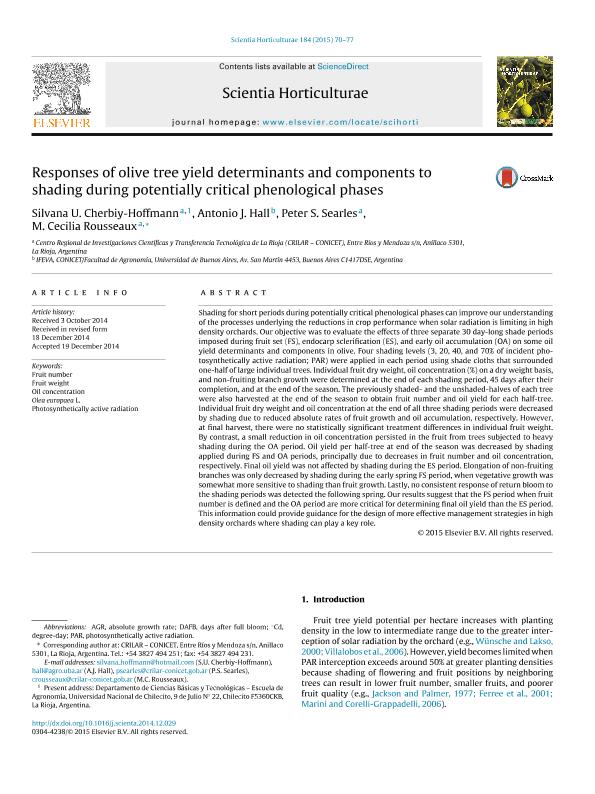Artículo
Responses of olive tree yield determinants and components to shading during potentially critical phenological phases
Cherbiy Hoffmann, Silvana Ursula ; Searles, Peter Stoughton
; Searles, Peter Stoughton ; Hall, Antonio Juan
; Hall, Antonio Juan ; Rousseaux, Maria Cecilia
; Rousseaux, Maria Cecilia
 ; Searles, Peter Stoughton
; Searles, Peter Stoughton ; Hall, Antonio Juan
; Hall, Antonio Juan ; Rousseaux, Maria Cecilia
; Rousseaux, Maria Cecilia
Fecha de publicación:
03/2015
Editorial:
Elsevier Science
Revista:
Scientia Horticulturae
ISSN:
0304-4238
Idioma:
Inglés
Tipo de recurso:
Artículo publicado
Clasificación temática:
Resumen
Shading for short periods during potentially critical phenological phases can improve our understanding of the processes underlying the reductions in crop performance when solar radiation is limiting in high density orchards. Our objective was to evaluate the effects of three separate 30 day-long shade periods imposed during fruit set (FS), endocarp sclerification (ES), and early oil accumulation (OA) on some oil yield determinants and components in olive. Four shading levels (3, 20, 40, and 70% of incident photosynthetically active radiation; PAR) were applied in each period using shade cloths that surrounded one-half of large individual trees. Individual fruit dry weight, oil concentration (%) on a dry weight basis, and non-fruiting branch growth were determined at the end of each shading period, 45 days after their completion, and at the end of the season. The previously shaded- and the unshaded-halves of each tree were also harvested at the end of the season to obtain fruit number and oil yield for each half-tree. Individual fruit dry weight and oil concentration at the end of all three shading periods were decreased by shading due to reduced absolute rates of fruit growth and oil accumulation, respectively. However, at final harvest, there were no statistically significant treatment differences in individual fruit weight. By contrast, a small reduction in oil concentration persisted in the fruit from trees subjected to heavy shading during the OA period. Oil yield per half-tree at end of the season was decreased by shading applied during FS and OA periods, principally due to decreases in fruit number and oil concentration, respectively. Final oil yield was not affected by shading during the ES period. Elongation of non-fruiting branches was only decreased by shading during the early spring FS period, when vegetative growth was somewhat more sensitive to shading than fruit growth. Lastly, no consistent response of return bloom to the shading periods was detected the following spring. Our results suggest that the FS period when fruit number is defined and the OA period are more critical for determining final oil yield than the ES period. This information could provide guidance for the design of more effective management strategies in high density orchards where shading can play a key role.
Archivos asociados
Licencia
Identificadores
Colecciones
Articulos(CRILAR)
Articulos de CENTRO REGIONAL DE INV. CIENTIFICAS Y TRANSFERENCIA TECNOLOGICA DE ANILLACO
Articulos de CENTRO REGIONAL DE INV. CIENTIFICAS Y TRANSFERENCIA TECNOLOGICA DE ANILLACO
Citación
Cherbiy Hoffmann, Silvana Ursula; Searles, Peter Stoughton; Hall, Antonio Juan; Rousseaux, Maria Cecilia; Responses of olive tree yield determinants and components to shading during potentially critical phenological phases; Elsevier Science; Scientia Horticulturae; 184; 3-2015; 70-77
Compartir
Altmétricas



